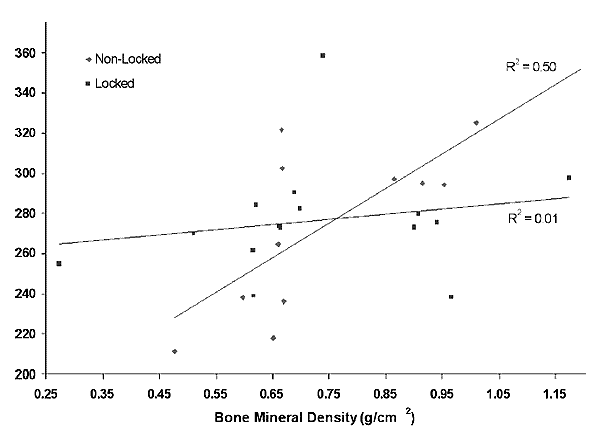
Correlation between BMD and strength of locked or unlocked constructs after fatigue loading.
Sat., 10/10/09 Basic Sci./Injury Prevent./Spine, Paper #70, 10:56 am OTA-2009
Does Bone Mineral Density Influence the Strength of Locked and Unlocked Plates?
Paul Tornetta III, MD1 (3,5A, 7-Smith &Nephew; 8-Exploramed);
William M. Ricci, MD2 (3, 4, 5A, 7-Smith &Nephew; 4, 7-AO, 4, 5A-Wright Medical
Technology, Inc.; 5A, 7-Synthes); Jacob Carnter, BA3 (5-Smith &Nephew);
Yanming Zheng, PhD3 (5-Smith &Nephew);
1Boston University Medical Center, Boston, Massachusetts, USA;
2Washington University Orthopaedic Trauma, Saint Louis, Missouri, USA;
3Smith &Nephew, Inc., Memphis, Tennessee, USA
Purpose: Obtaining adequate fracture fixation for plates is dependent upon the mechanical integrity of the bone/plate interface. Locked plates have shown theoretical advantages in poor-quality bone. While many studies have used osteoporotic bone to compare locked and unlocked constructs, no attempt has been made to examine the relationship of bone mineral density (BMD) to the fixation strength. We sought to evaluate the effect of BMD on the strength of locked and unlocked plate constructs using a paired cadaveric distal femoral fracture model.
Methods: 30 human cadaveric femora (15 matched pairs) were harvested for this study. Dual-energy x-ray absorptiometry (DEXA) screening was performed on all bones to obtain BMD. An extra-articular metaphyseal 3-cm gap was then created to simulate a comminuted OTA 33-A1 fracture. All bones were instrumented using distal femoral locking plates (Smith & Nephew). Metaphyseal fixation in all specimens was accomplished with locking screws. Diaphyseal fixation was locked on one femur and unlocked on the contralateral side of each pair. All specimens were potted and subjected to an axial cyclic compressive bending load of 50/500 N with a physiological varus moment at 2 Hz for 500,000 cycles to allow comparison after fatigue. After 500,000 cycles, a constant load was applied until catastrophic failure occurred via diaphyseal screw loosening, plate deformation, or bone fracture.
Results: DEXA revealed a BMD range of 0.27 to 1.19 g/cm2 for the bones utilized. BMD had no influence on the strength of the locked constructs, with the correlation being close to zero (R2 = 0.01). For the unlocked constructs, the BMD did correlate with the strength of the construct (R2 = 0.5) (see figure)

Correlation between BMD and strength of locked or unlocked constructs after fatigue loading.
• The FDA has not cleared this drug and/or medical device for the use described in this presentation (i.e., the drug or medical device is being discussed for an “off label” use). ◆FDA information not available at time of printing. Δ OTA Grant